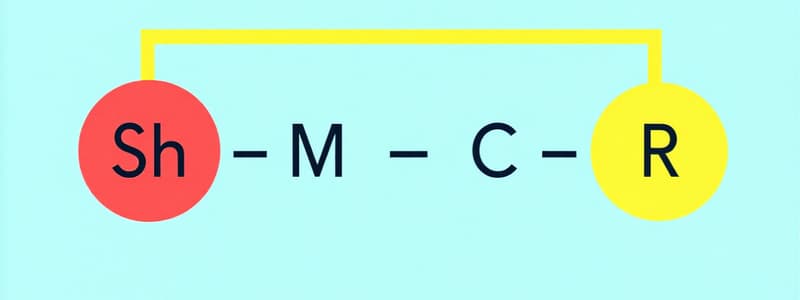Podcast
Questions and Answers
What does Berlo's S-M-C-R communication model emphasize as its core components?
What does Berlo's S-M-C-R communication model emphasize as its core components?
- Source, Medium, Context, Response
- Sender, Medium, Context, Receiver
- Sender, Message, Channel, Receiver (correct)
- Sender, Message, Context, Response
Which model focuses on the role of feedback and shared meaning between communicators?
Which model focuses on the role of feedback and shared meaning between communicators?
- Shannon-Weaver communication model
- Westley and Maclean communication model
- Dance’s Helical communication model
- Osgood-Schramm communication model (correct)
In transactional models of communication, what is the key difference compared to linear models?
In transactional models of communication, what is the key difference compared to linear models?
- Communication is seen as a unidirectional process
- Feedback is incorporated in the communication process (correct)
- Only the sender holds the responsibility of communication
- Messages are static and have fixed meanings
Which communication model is represented as a continuous return loop, illustrating the ongoing nature of communication?
Which communication model is represented as a continuous return loop, illustrating the ongoing nature of communication?
What aspect of communication is notably absent in the Shannon-Weaver model?
What aspect of communication is notably absent in the Shannon-Weaver model?
Flashcards are hidden until you start studying
Study Notes
Linear Models of Communication
- Linear models present communication as a one-way process, where a sender transmits a message to a receiver without feedback.
The Shannon-Weaver Communication Model
- Developed by Claude Shannon and Warren Weaver in 1948.
- Consists of five key components: sender, encoder, channel, decoder, and receiver.
- Introduces the concept of noise, which can hinder message transmission.
Berlo’s S-M-C-R Communication Model
- Developed by David Berlo in 1960.
- S-M-C-R stands for Source, Message, Channel, and Receiver.
- Highlights the importance of the source's communication skills, message clarity, channel choice, and receiver’s understanding.
Interactive Models of Communication
- These models account for feedback between the sender and receiver, emphasizing that communication is a two-way process.
The Osgood-Schramm Communication Model
- Created by Charles Osgood and Wilbur Schramm in 1954.
- Focuses on the cyclical nature of communication, involving encoding and decoding processes.
- Highlights the importance of shared experiences for effective understanding.
The Westley and Maclean Communication Model
- Proposed by Daniel Westley and Malcolm Maclean in 1957.
- Emphasizes the role of mass communication and its impact on public opinion.
- Introduces multiple feedback channels, acknowledging the influence of various communicators.
Transactional Models of Communication
- Transactional models view communication as a simultaneous process where all parties are involved in sending and receiving messages.
Barnlund’s Transactional Communication Model
- Developed by Dean Barnlund in 1970.
- Portrays communication as an ongoing process where all participants share roles simultaneously.
- Recognizes the dynamic nature of context, noise, and feedback in communication.
Dance’s Helical Communication Model
- Introduced by Frank Dance in 1967.
- Represents communication as a helix, illustrating that communication evolves over time through continuous interaction.
- Suggests that past experiences influence present and future communication efforts.
Studying That Suits You
Use AI to generate personalized quizzes and flashcards to suit your learning preferences.




